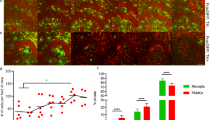Abstract
A PATHOLOGICALhallmark of Alzheimer's disease is the senile plaque, containing β-amyloid fibrils, microglia and astrocytes1. β-amyloid fibrils exert a cytotoxic effect on neurons2, and stimulate microglia to produce neurotoxins, such as reactive oxygen species3,4. Mononuclear phagocytes, including microglia, express scavenger receptors that mediate endocytosis of oxidized low-density lipoproteins5, and adhesion to glucose-modified extracellular matrix proteins6. Here we report that class A scavenger receptors mediate adhesion of rodent microglia and human monocytes to β-amyloid fibril-coated surfaces leading to secretion of reactive oxygen species and cell immobilization. Thus, class A scavenger receptors are potential therapeutic targets in Alzheimer's disease.
This is a preview of subscription content, access via your institution
Access options
Subscribe to this journal
Receive 51 print issues and online access
$199.00 per year
only $3.90 per issue
Buy this article
- Purchase on SpringerLink
- Instant access to full article PDF
Prices may be subject to local taxes which are calculated during checkout
Similar content being viewed by others
References
Wisniewski, H. M. et al. J. Neuropath, exp. Neurol. 48, 606–609 (1989).
Lorenzo, A. & Yankner, B. A. Proc. natn. Acad. Sci. U.S.A. 91, 12243–12247 (1994).
Meda, L. et al. Nature 374, 647–650 (1995).
Klegeris, A., Walker, D. G. & McGeer, P. L. Biochem. biophys. Res. Commun. 199, 984–991 (1994).
Krieger, M. & Herz, J. A. Rev. Biochem. 63, 601–637 (1994).
El Khoury, J. et al. J. biol. Chem. 269, 10197–10200 (1994).
Jiang, H. et al. J. Immun. 152, 5050–5059 (1994).
Smith, M. A. et al. Proc. natn. Acad. Sci. U.S.A. 91, 5710–5714 (1994).
Vitek, M. P. et al. Proc. natn. Acad. Sci. U.S.A. 91, 4766–4770 (1994).
Giulian, D. & Baker, T. J. Neurosci. 6, 2163–2178 (1986).
Narindrasorasak, S. et al. Lab. Invest. 72, 272–282 (1995).
Sisodia, S. S. & Price, D. L. FASEB J. 9, 366–370 (1995).
Elghetany, M. T., Saleem, A. & Ban, K. Annls clin. lab. Sci. 19, 190–195 (1989).
Fraser, I., Hughes, D. & Gordon, S. Nature 364, 343–346 (1993).
Bell, M. D. et al. J. Neurocytol. 23, 605–613 (1994).
Christie, R. H., Freeman, M. & Hyman, B. T. Am. J. Path. 148, 399–403 (1996).
Ausubel, F. M. et al. (eds). Curr. Prot. Mol. Biol. 1, 921–926 (1993).
Hartung, H.-P. et al. Lab. Invest. 55, 209–216 (1986).
Quinn, M. T. et al. Proc. natn. Acad. Sci. U.S.A. 84, 2995–2998 (1987).
Pike, C. J. et al. J. Neurochem. 64, 253–265 (1995).
Akeson, A. L. & Woods, C. W. J. immunol. Meth. 163, 181–186 (1993).
Wan, C. P., Myung, E. & Lau, B. H. S. J. immunol. Meth. 159, 131–138 (1993).
Loike, J. D. et al. J. exp. Med. 181, 1763–1772 (1995).
Author information
Authors and Affiliations
Rights and permissions
About this article
Cite this article
Khoury, J., Hickman, S., Thomas, C. et al. Scavenger receptor-mediated adhesion of microglia to β-amyloid fibrils. Nature 382, 716–719 (1996). https://doi.org/10.1038/382716a0
Received:
Accepted:
Issue Date:
DOI: https://doi.org/10.1038/382716a0
This article is cited by
-
Nanotechnology for microglial targeting and inhibition of neuroinflammation underlying Alzheimer’s pathology
Translational Neurodegeneration (2024)
-
Molecular subtypes of ALS are associated with differences in patient prognosis
Nature Communications (2023)
-
Strategies for Manipulating Microglia to Determine Their Role in the Healthy and Diseased Brain
Neurochemical Research (2023)
-
Novel Somatostatin Receptor-4 Agonist SM-I-26 Mitigates Lipopolysaccharide-Induced Inflammatory Gene Expression in Microglia
Neurochemical Research (2022)
-
p38 Inhibition Decreases Tau Toxicity in Microglia and Improves Their Phagocytic Function
Molecular Neurobiology (2022)



